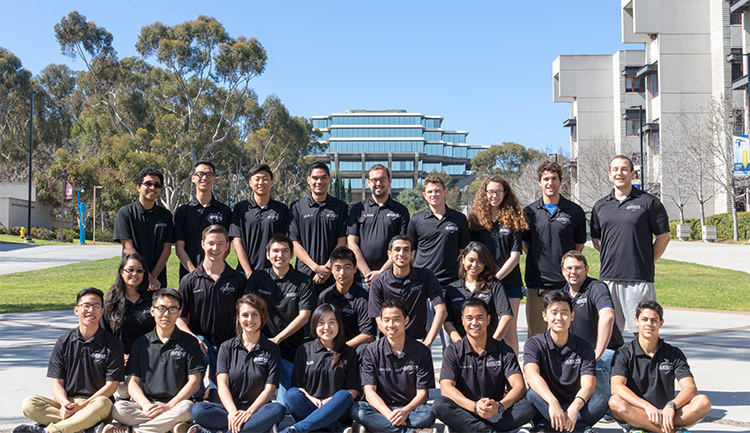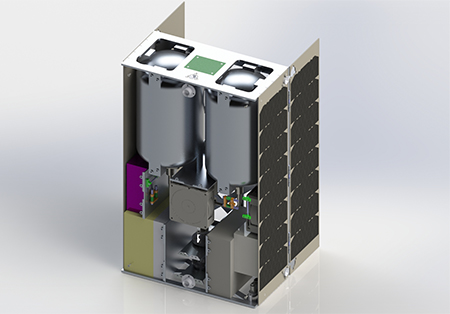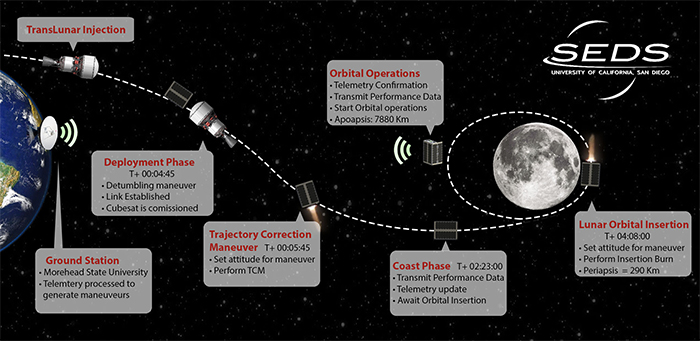By:
- Deborah Osae-Oppong
Published Date
By:
- Deborah Osae-Oppong
Share This:
NASA Competition Win Puts Engineering Undergrads Closer to Launching Satellite into Lunar Orbit

The Students for the Exploration and Development of Space (SEDS) Cubesat Team at the University of California San Diego.
A team of engineering undergraduates at UC San Diego is one step closer to sending a satellite into orbit around the moon after placing third in a NASA satellite design competition. The win comes with a $30,000 award and gives their design a good shot at a spot aboard NASA’s Orion capsule as part of its first unmanned lunar flyby, planned for 2018.
The undergraduates from the Jacobs School of Engineering are already experts in 3D-printed rocket engines. Now, they’re making their mark in satellite design by incorporating a 3D-printed engine in a “CubeSat,” a cube-shaped satellite approximately 30 centimeters across (about the size of a large Cheerios box).
“We’re a group of undergraduates, and we had no experience with satellites. It was sheer willpower that got us to this point, and it just goes to show how much talent we have in our organization,” said Darren Charrier, a sophomore aerospace engineering major and one of the leaders of Students for the Exploration and Development of Space (SEDS) at UC San Diego.
CubeQuest
The competition, called the CubeQuest Challenge, is NASA’s $5 million challenge that requires teams to design, build and deliver flight-qualified nanosatellites capable of advanced research operations near and beyond the moon.

Interior view of the cubesat
NASA's Space Launch System will get the selected payloads out of the atmosphere and past Earth’s Van Allen belts.
“At this point, the payloads are released,” said Charrier. “They are going extremely fast, so the first job of the engine is to get the satellite to slow down. The engine is supposed to ‘park’ the satellite, taking it off of its approach path and sending it into orbit around the moon as soon as possible. We want to get the satellite parked in orbit in one shot, and in under 15 minutes.”
Existing technologies can take days or even months to get a satellite into orbit. But the SEDS design includes a chemical propulsion unit that, unlike traditional CubeSat technologies, can achieve orbit in a fraction of that time. Once there, the satellite should stay in orbit for a year.
Learning to Lead
After placing second to last in the first leg of the competition in 2015, Charrier got involved with the Gordon Center for Engineering Leadership at the UC San Diego.
As part of the Gordon Scholars Program, Charrier joined a community of undergraduate engineering students given a wide range of opportunities to learn to lead teams to success.
“I learned a lot about project management and situational leadership, how to integrate new team members,” said Charrier. “We focused on the questions, ‘What are our goals for this project?’ and ‘What are they looking for?’ ” The result was the third place finish and $30,000 in reseach and development funds from NASA.

Mission overview
Gordon Scholars also complete challenge projects in which they demonstrate leadership skills. Christopher Ellis, a fourth-year electrical engineering major and member of the SEDS team is also a Gordon Scholar. He is designing the power supply for their microsatellite—from scratch.
“We want to make UC San Diego a top aerospace and space industry school,” said Charrier, who also noted that SEDS is helping UC San Diego put out some of the best engineers in the country. “SEDS is set apart by its leadership and culture. It’s a culture of intensity, hard work and personal growth. Everyone in the organization is passionate about what they do. We work like a startup, and have seen positive results.”
In this leg of the NASA CubeQuest Challenge, the UC San Diego team was only bested by teams from MIT and Cornell.
The SEDS team will need to raise a total of $250,000 in cash funding and in-kind donations for this project. The team is actively working with local companies. SEDS is grateful to Space Micro, Qualcomm, and MTI for their sponsorship, Charrier said.
The SEDS team is mentored by Kalyanasundaram Seshadri, a UC San Diego professor of mechanical and aerospace engineering.
Share This:
Stay in the Know
Keep up with all the latest from UC San Diego. Subscribe to the newsletter today.



